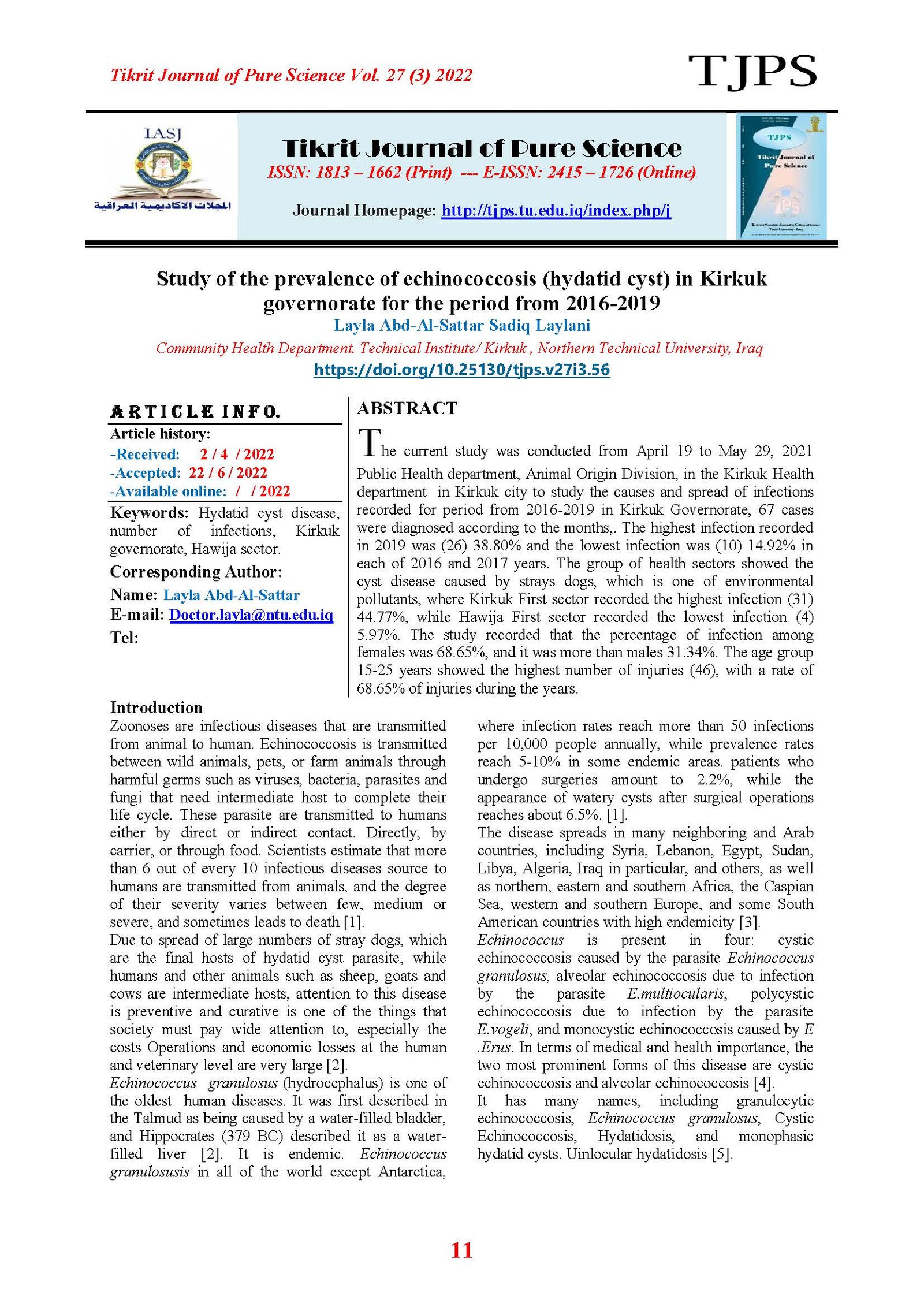Study of the prevalence of echinococcosis (hydatid cyst) in Kirkuk governorate for the period from 2016-2019
Main Article Content
Abstract
The current study was conducted from April 19 to May 29, 2021 Public Health department, Animal Origin Division, in the Kirkuk Health department in Kirkuk city to study the causes and spread of infections recorded for period from 2016-2019 in Kirkuk Governorate, 67 cases were diagnosed according to the months,. The highest infection recorded in 2019 was (26) 38.80% and the lowest infection was (10) 14.92% in each of 2016 and 2017 years. The group of health sectors showed the cyst disease caused by strays dogs, which is one of environmental pollutants, where Kirkuk First sector recorded the highest infection (31) 44.77%, while Hawija First sector recorded the lowest infection (4) 5.97%. The study recorded that the percentage of infection among females was 68.65%, and it was more than males 31.34%. The age group 15-25 years showed the highest number of injuries (46), with a rate of 68.65% of injuries during the years.
Article Details

This work is licensed under a Creative Commons Attribution 4.0 International License.
Tikrit Journal of Pure Science is licensed under the Creative Commons Attribution 4.0 International License, which allows users to copy, create extracts, abstracts, and new works from the article, alter and revise the article, and make commercial use of the article (including reuse and/or resale of the article by commercial entities), provided the user gives appropriate credit (with a link to the formal publication through the relevant DOI), provides a link to the license, indicates if changes were made, and the licensor is not represented as endorsing the use made of the work. The authors hold the copyright for their published work on the Tikrit J. Pure Sci. website, while Tikrit J. Pure Sci. is responsible for appreciate citation of their work, which is released under CC-BY-4.0, enabling the unrestricted use, distribution, and reproduction of an article in any medium, provided that the original work is properly cited.
References
[1] WHO, World Health Organization (2021). Echinococcosis. Retrieved May17. From
https://www.who.int/news-room/fact-sheets/detail/echinococcosis .
[2] Eckert, J. & Deplazes, P. (2004). Biological, epidemiological, and clinical aspects of echinococcosis, a zoonosis of increasing concern, clin. Microbiol. Rev. , 17(1): 107-135.
[3] Gemmell MA; Roberts MG; Beard TC; Campano Diazs; Lawson JR and Nonnemaker JM; (2001) Control of echinococcosis. In: WHO /OIE manual on echinococcosis in humans and animals: a pullic health problem of glolalconcern (Eckert J,Gemmell MA; Meslin F-X and Pawlowski ZS, eds.), Paris, France: 195-237.
[4] Nunnari, G.; Pinzone, M. P.; Gruttaduria, S.; Celesia, B. M.; Madeddu, G.; Malaguarnera, G.; Pavone, P. Cappellani, A. & Cacopardo, B .(2012). Hepatic echinococcosis : clinical and therapeutic aspects. World. J. Gastroenterol., 18: 1448 – 1458.
[5] Roberts, L.S. & Janovy, J.Jr. (2000). Schmidt & Roberts' foundations of parasitology, 6th edn. McGraw-Hill Book Co. , New York: pp. 670. [6] Moro P, Schantz PM. (2009). "Echinococcosis: a review". Int. J. Infect.. 13 (2): 33-125.
[7] Daoud, Ibrahim Shaaban & Al-Rawi, Bandar Abdul-Karim. (1987). Parasitology. Baghdad University Press: p. 630.
[8] Karyakarte, R. P. & Damle, A. S. (2004). Medical parasitology. Books and Allied (P) Ltd. PP. 137 – 142.
[9] Al-Ghazi, Zahra Saadoun Hadi (2008). Epidemiology and diagnosis of Hydatid disease in humans and ruminants in Dhi Qar Governorate. Master's thesis - College of Education - Dhi Qar University. p. 139.
[10] Khalf, M. S.; AlTaie, L. H. & AlFaham, M. A. (2014). The incedance of hydatid cyst in human in Baghdad governorate.IOSR. J. Pharm. Bio. Sci., 9(3): 11 – 14.
[11] Al-Yasari, H. F.; Al-Shaiely, A. K. & Al-Hassani, N. A.(2013). A study of human hydatidosis : Demographically and Clinically in Hilla city. J. Babyl. Univ. Pure and Applied. Sci., 8(21) : 2873 – 2881.
[12] Getachew, D.; Jizat, A. & Getachew, T. (2012). Occurrence and fertility rates of hydatid cyst in sheep and goats slaughtered at Modjo Luna Export slaughter house, Ethiopia. Ethiop. Vet. J., 16:83 – 9.
[13] Al-Moanis, Mahmoud Salem Thamer (1998). An epidemiological and immunological study of hydatid cyst patients in Basra Governorate (southern Iraq). PhD thesis - College of Education - University of Basra. p. 174
[14] Al-Tufaili, R. A. N.(2014). Epidemiology of cystic echinococcosis in Al-Najaf province. Kufa. J. Vet. Med. Sci., 5(2): 249 – 257.
[15] Craig, P. S.; Gasser, R. B.; Parada, L.; Cabrera, P.; Parietti, S.; Borgues, C.; Acuttis, A.; Agulla, J.; Snowden, K. & Paolillo, E.(2007). Diagnosis of canine echinococcosis :Comparison of coproantigen and serum antibody tests with arecoline purgation in Uruguay.Vet. Parasitol., 144: 287-292.
[16] Yacoub, A; Bakr, S.; Hameed, A.; Al-Thamery, A. & Fartoci, M.(2006). Seroepidemiology of
echinococcosis. Emerg. Infect. Dis., 12 : 296 – 303.
